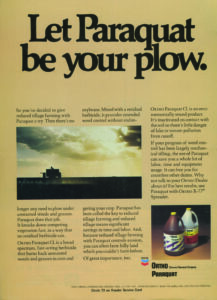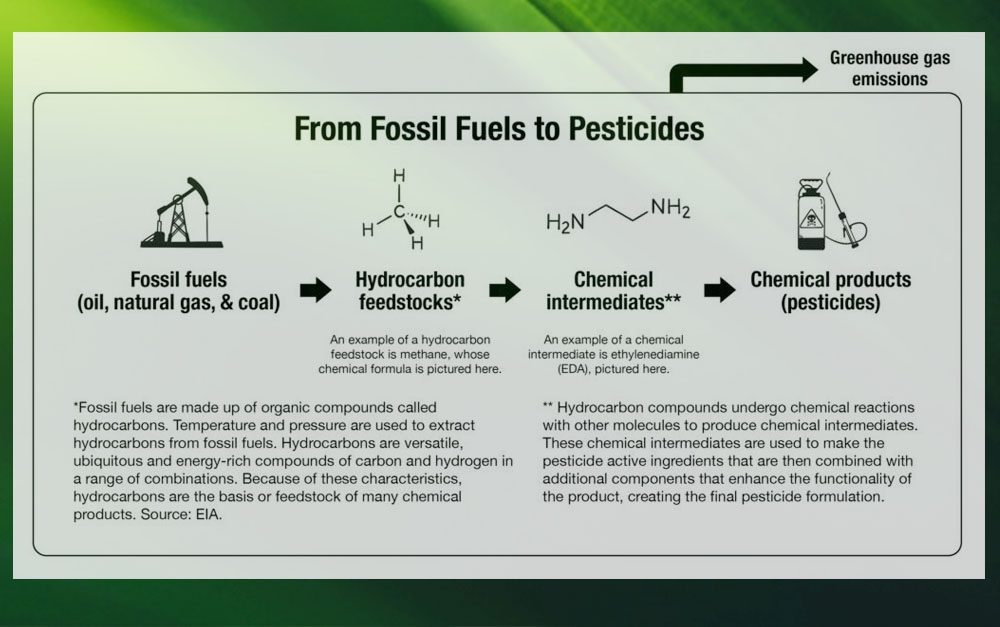Did you know that the greenhouse gas emissions associated with the production, transportation, and application of pesticides are strongly linked to fossil fuels? In fact, 99% of all synthetic chemicals, which include pesticides, are derived from fossil fuels. And it isn’t surprising that several oil and gas companies (like Chevron, Shell and ExxonMobil) play major roles in developing pesticide ingredients and profiting from their use.
Pesticide manufacturing and greenhouse gases
Researchers have calculated the energy use associated with the production of specific pesticides, which can then be used to estimate carbon dioxide emissions. For example, the greenhouse gas emissions that result from the manufacture of glyphosate, the world’s most popular herbicide, produces 31.29 kilograms of carbon dioxide equivalent (CO2e) per kilogram of product (Audsley, et al). Several pesticides produce amounts greater than 40 kilograms of CO2e per kilogram. To put this in perspective, the energy used to produce the amount of glyphosate used globally in 2014 was equal to the energy needed to fuel about 6.25 million cars for a single year.
While it would be useful to have more recent research, the data still paint a picture that is relevant today. On average:
- Herbicide production creates 18.22 to 26.63 kg of CO2e per kg
- Insecticide production creates 14.79 to 18.91 kg of CO2e per kg
- Fungicide production creates 11.94 to 29.19 kg of CO2e per kg
These numbers result in a significant contribution to the total greenhouse gas emissions that have played a role in a changing climate.
Hydrocarbons to pesticides
A pesticide consists of both active and inert ingredients. The active ingredients kill the pests (weeds, insects, fungi) and the inert ingredients make it easier to apply the product, coat the target plant and extend the effectiveness of the product. Many pesticides are also coated in microplastics, which are classified as an inert and derived from fossil fuels, to ensure more controlled release of the product.
Most active ingredients are synthesized from hydrocarbons derived from petroleum, known as hydrocarbon feedstocks. These feedstocks are combined with other elements, such as chlorine, oxygen, sulfur, phosphorus, nitrogen and bromide to create chemical intermediates. This process is responsible for the greenhouse gas emissions that result from the creation of pesticides.
Various inert ingredients are then added to formulate the final pesticide product. Some of these inert ingredients are recognized as active ingredients in other pesticides and some inert ingredients are biologically active and are potentially, or are verified to be, toxic.
Research doesn’t account for the entire story
The calculations provided in the study of greenhouse gas emissions by pesticides only factor in the energy used to produce the active ingredients. A true estimate would also include other stages of a pesticide’s lifecycle. Transportation, pesticide application and post-application effects are all omitted from the calculated emission levels. These numbers also fail to include the energy needed to formulate the final pesticide products and manufacture the inert ingredients, which typically account for most of the volume of a pesticide. For instance, inert ingredients make up as much as 50–75% of glyphosate products.
More than 500 of these so-called inert ingredients have been or are currently used as active ingredients, yet due to proprietary protections, the identification and volume of these ingredients are kept secret from the public (Cox and Surgan). This makes it impossible to calculate energy requirements for the manufacture of pesticide products in their entirety.
Fossil fuel and pesticide industries pouring out the carbon
Fossil fuel corporations like Chevron have been advertising their pesticide products to farmers for decades – like this 1972 featured in the publication No Till Farmer. Paraquat is an herbicide with links to Parkinson’s Disease.

Since World War II, pesticides have typically been synthesized from petroleum or petroleum by-products and petroleum industry giants ExxonMobil, ChevronPhillips Chemical and Shell, all produce pesticides or their chemical precursors. Multiple pesticide corporations self-report high CO2e emissions related to their operations. For instance, 9.8 million tonnes of CO2e directly or indirectly resulted from Syngenta’s operations in 2021 – the rough equivalent to the annual carbon dioxide emissions of more than 2 million passenger vehicles.
Would you like to learn more?
Climate change is one of the greatest challenges facing humanity today. Scientific evidence indicates that pesticides contribute significantly to greenhouse gas emissions while also making our agricultural systems more vulnerable to the effects of climate change. You can view our full report if you would like to learn more.
But we’re not just talking about the problem. You can view each of our webinars. The first summarizes our report and the second focuses on the solutions available to us if we adopt the principles of agroecology. We can make a difference, and that difference can start by moving away from reliance on pesticides.
Print bibliography:
Audsley, E., Stacey, K. F., Parsons, D. J., & Williams, A. G. (2009). Estimation of the greenhouse gas emissions from agricultural pesticide manufacture and use. Cranfield University.
Cox, C., & Surgan, M. (2006). Unidentified inert ingredients in pesticides: implications for human and environmental health. Environmental Health Perspectives, 114(12), 1803-1806.







